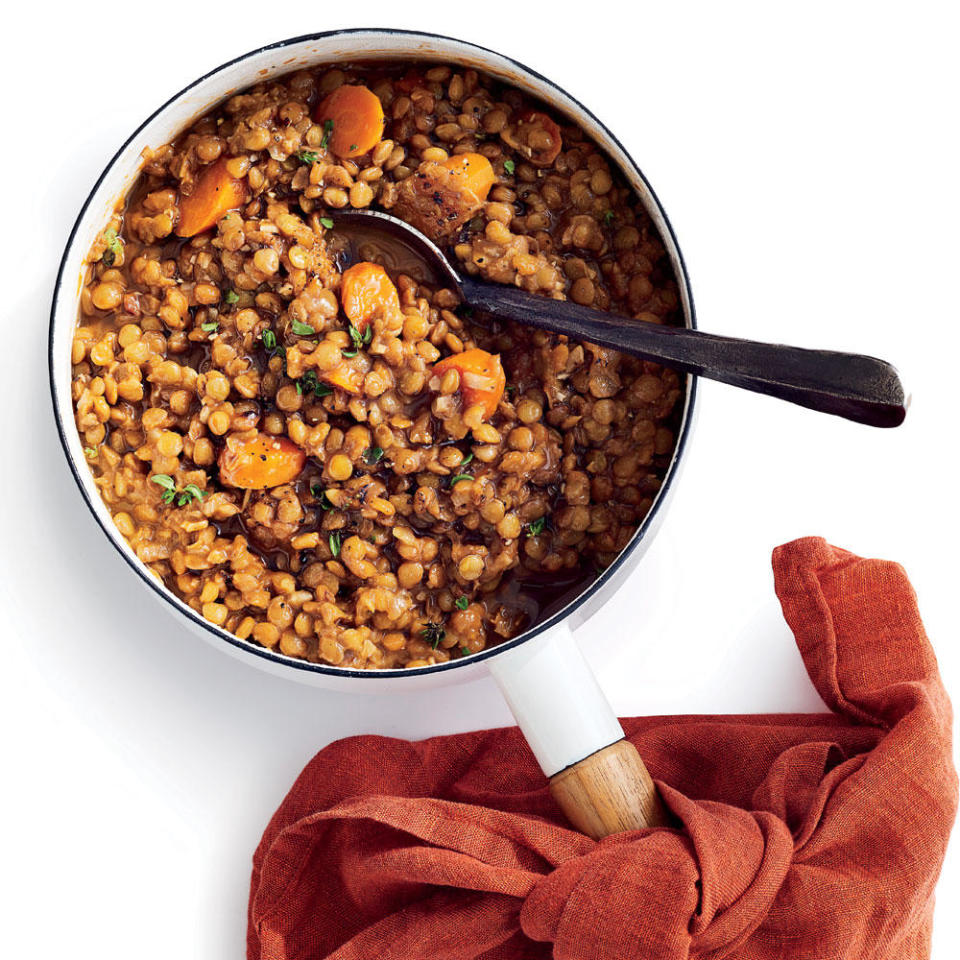Are Lentils Healthy, and Can You Eat Them Raw?

A bag of dry lentils is one of those foods you bring home with good intentions, only to find it in your pantry weeks later and realize you still have no idea what to do with it. You could throw some in soup, but it's too hot for that. You could make a salad, but how long does that take? Could you eat them raw? Maybe they could bulk up a smoothie? But is that even safe? (Hint: It's not! Read below to find out why).
If you want to become a person who doesn’t toss dusty bags of lentils after years of neglect, let’s dig deeper into what lentils are, what makes them so healthy, and how to make them super tasty and delicious.
Lentil Lowdown

Lentils are legumes—cousins to beans, chickpeas, soybeans and peanuts. The name "lentil" actually comes from the Latin word for "lens," which makes sense since the dried bean looks like a little lens.
Like many other beans, they've been used in cooking for centuries and are thought to have originated in the Near East. But they're routinely cultivated (and a part of the cuisine) throughout Europe, Asia, and North Africa. This means you can find lentils in some of their most well-known dishes, such as Indian Dal, Ethiopian stew, and Egyptian Koshari. And because they've spread so far, there are a wide variety of different types of lentils you can cook with. Here are some of the types:
Green Lentils
Also referred to as French lentils, green lentils hold up well after cooking and have a nutty taste. They're an ideal addition to a salad or on their own as a side dish. Beware, they require a bit more patience to prepare than other varieties, taking nearly 45 minutes to cook.
Get Recipe: Warm Bacon-Dijon Lentil Salad with Goat Cheese Crostini
Red and Yellow Lentils
With a sweeter flavor, these lentils are commonly utilized in Indian and Middle Eastern dishes. Although they are quick to prepare, they are more prone to lose their texture after being cooked. Consider using them in pureed soups or sauces to add a unique twist to your main dish.
Get Recipe: Curried Lentil-and-Vegetable Stew
Black Lentils
Also called beluga lentils, they have an earthy flavor that compliments proteins or meaty vegetables, such as mushrooms, with a moderately low cooking time of 25 minutes.
Get Recipe: Wild Mushroom and Lentil Cottage Pie
Brown Lentils
Commonly used in North America, this is the variety you might often see staring back at you in your pantry. With a mild and earthy flavor and ability to hold their texture after being cooked, they can serve as a veggie burger base without overpowering the fresh veggie flavor.
Get Recipe: Lentil-Tahini Burgers with Pickled Cabbage
Health Benefits of Lentils

A cheap, nutrient-dense option, lentils may just become one of your new favorite foods. Here is the nutritional breakdown of a 1/2-cup serving of cooked brown lentils:
Calories: 115
Fat: 0g
Saturated Fat: 0g
Unsaturated Fat: 0g
Carbohydrates: 20g
Fiber: 8g
Protein: 9 g
Sugar: 2g
Added Sugars: 0
Source: USDA
In addition to their high protein and fiber content, which will keep you satiated for a relatively long period of time, there are a few other reasons you may want to make lentils an integral part of your diet. For instance, they are high in iron, a good source of phytochemicals, and can help control weight.
Can You Eat Lentils Raw?
The short answer? No.
Like other legumes, raw lentils contain a type of protein called lectin that, unlike other proteins, binds to your digestive tract, resulting in a variety of toxic reactions, such as vomiting and diarrhea. Yikes.
Luckily, lectins are heat sensitive, and break down into more digestible components when they're cooked! Some legumes, like red kidney beans, need to be brought to a boil to fully break down the lectins (here's a good all-purpose dried bean recipe). Unfortunately, most dried beans also need to then simmer for an hour or more.
But lentils typically cook much faster! Part of the reason is that they are smaller, but they also contain much lower levels of lectin than other beans. The levels of the specific lectin (called PHA) are measured in hemagglutinating units, or hau. According to the FDA, raw red kidney beans typically contain between 20,000 and 70,000 hau. Raw lentils? A 2012 paper published in the Indian Journal of Agricultural Biochemistry found between 513 and 617 hau. So don't worry if you accidentally undercook your batch—or if you made the mistake of trying to bulk up a smoothie with some uncooked lentil seeds. It may cause a little stomach grumbling, but shouldn't send you rushing to the bathroom. Still, we suggest cooking them to be safe.
Should Lentils Be Soaked?
Many legumes, such as red kidney beans, are typically soaked for hours, sometimes even overnight. The soaking helps neutralize lectins, which is important for legumes that have a high hau count.
Because lentils are low enough in PHA, the legume does not need to be soaked for hours. If you are up for it, you can soak your lentils to aid with digestion and for a shorter cooking time. Try soaking them with lemon juice or vinegar to prevent them from getting too soft. But if you are in a time crunch, presoaking is not required.
How to Cook Lentils

Start by rinsing your lentils to remove any debris, bring three cups of water to one cup of lentils to a boil, reduce heat and simmer until they are tender, which will take about 15-20 minutes. Yes, it is as simple as that, but if you want to spice up your lentils here are 16 of our favorite ways to make lentils.
Get Recipe: A Perfect Pot of Lentils

